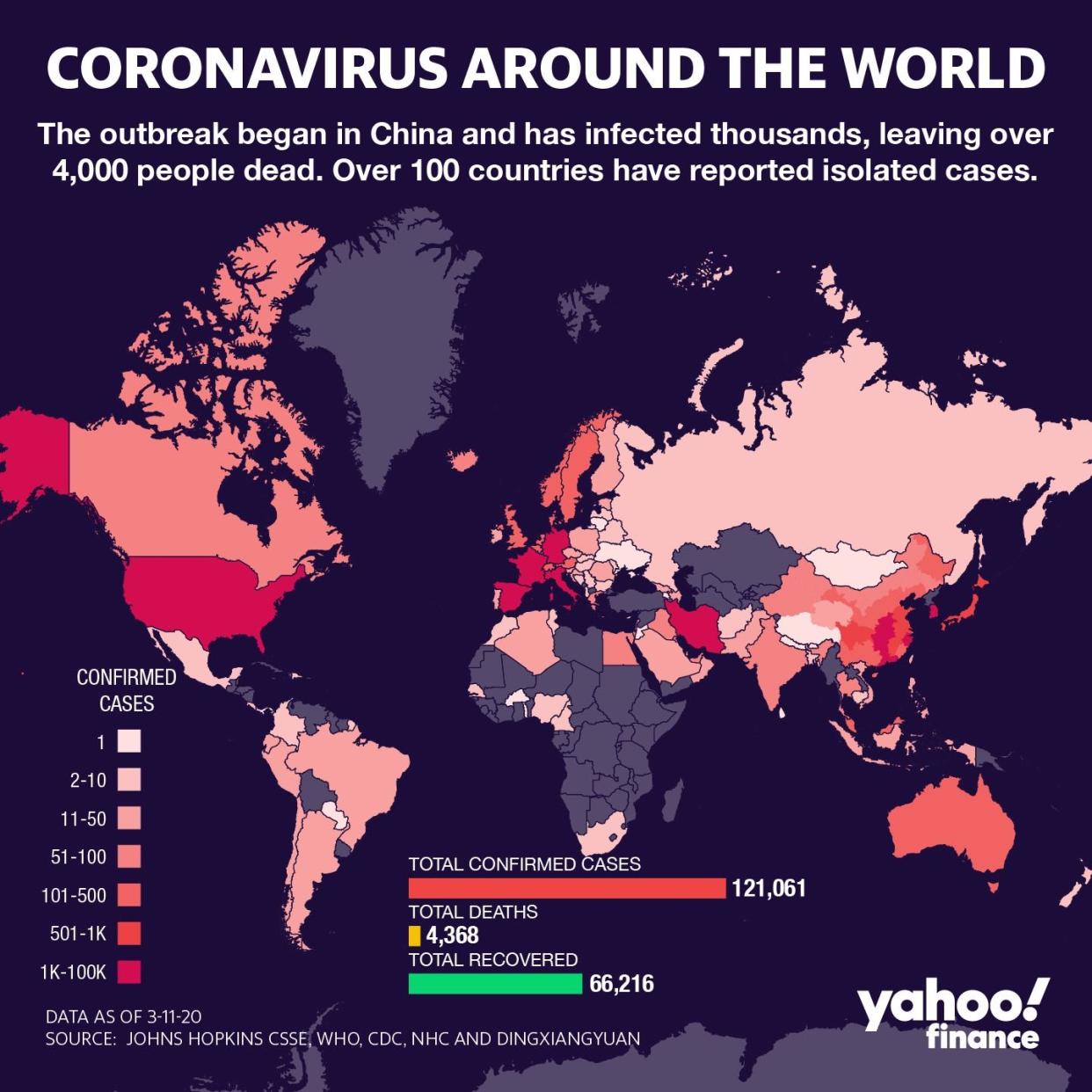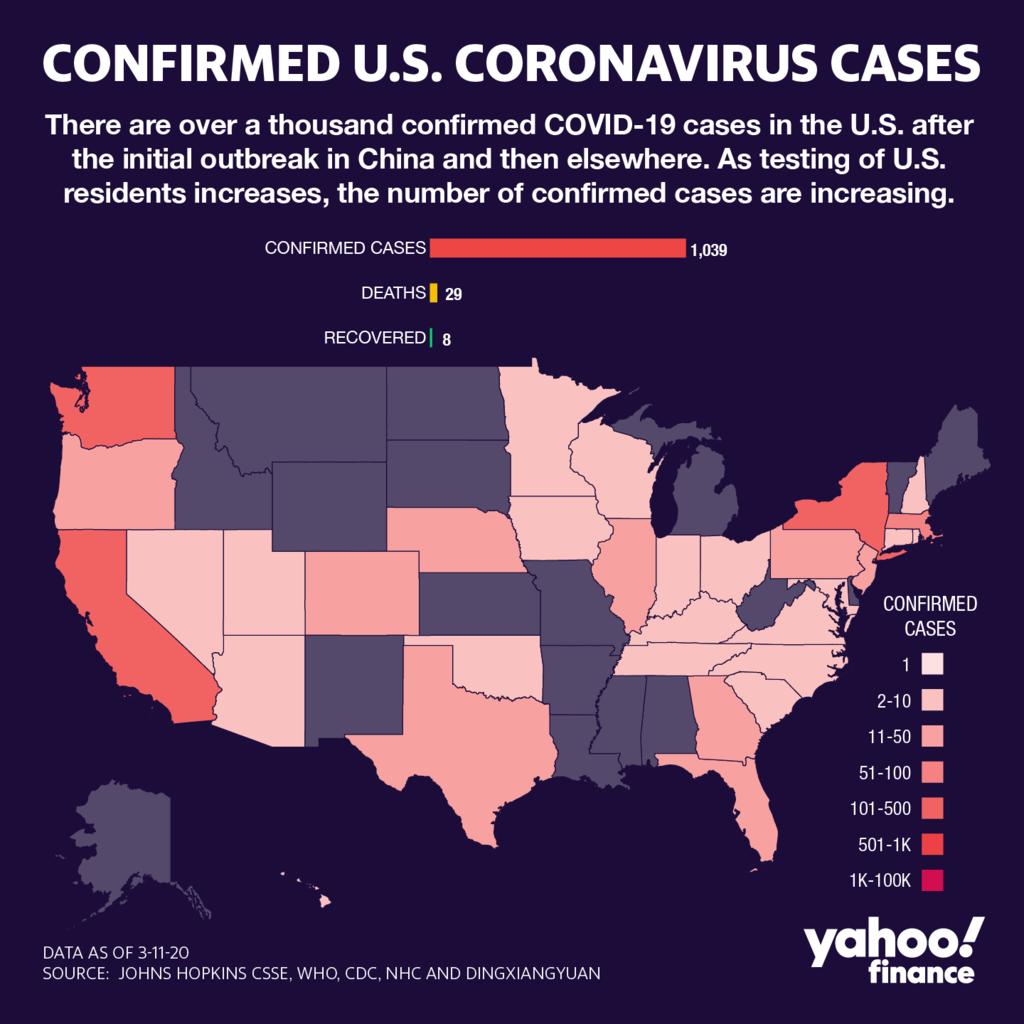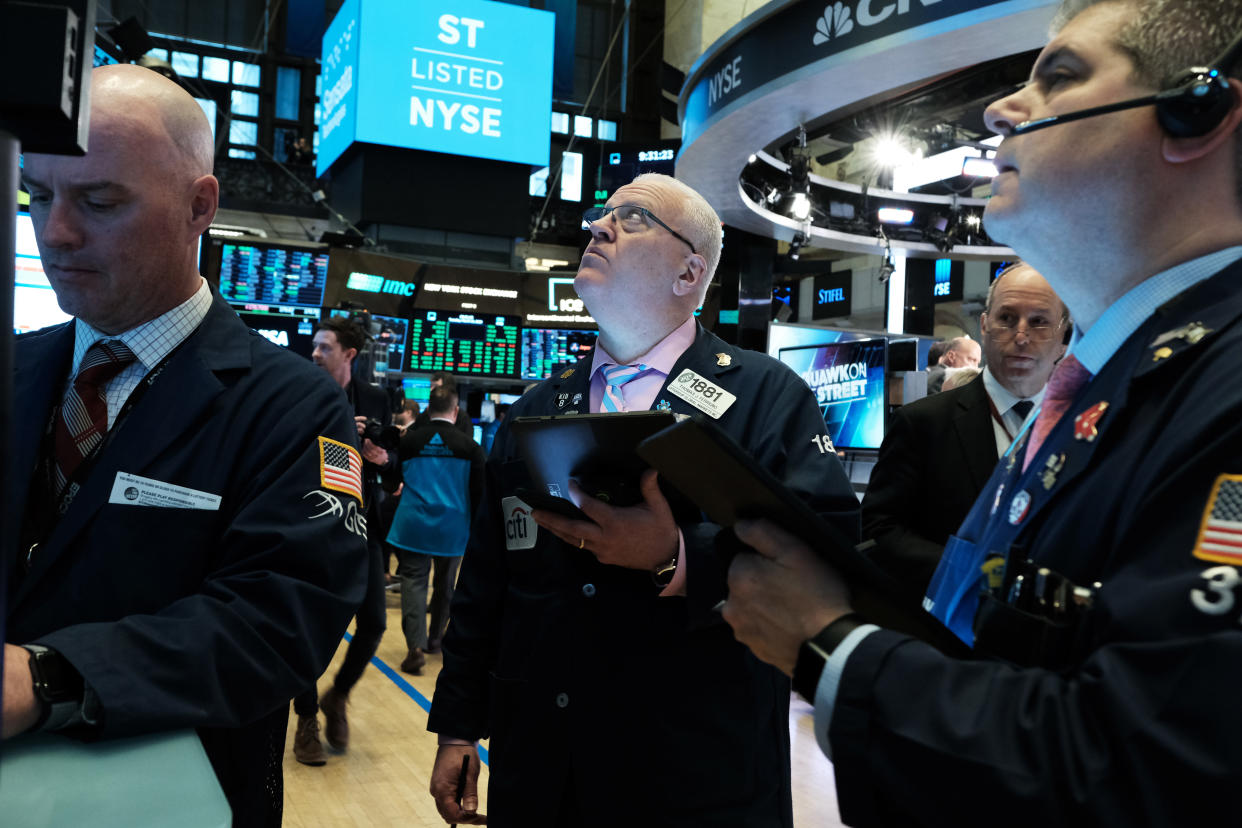Stock market news live: Dow drops 1,400 points, ending in bear market
[Click here to read what’s moving markets Thursday, March 12]
The S&P 500, Dow and Nasdaq tumbled Wednesday as the volatility of the past couple weeks extended further.
The Dow shed 1,464.94 points during the session, or 5.9%, sending it more than 20% below its recent high from February and into a bear market.
Midday Wednesday, the World Health Organization officially designated the coronavirus outbreak a pandemic, as the virus spread across more than 100 countries and infected well over 100,000 individuals. The Dow sank more than 1,200 points following the announcement.
Stocks’ afternoon leg lower extended declines from earlier in the regular and overnight sessions. During the pre-market session, stock futures slumped after the White House failed to offer further details on a stimulus package President Donald Trump earlier this week had characterized as “very major.” The measures reportedly in consideration included a payroll tax cut and expanded worker protections, to help counteract any economic fall-out from the ongoing coronavirus outbreak.

While further fiscal stimulus in the U.S. remains a point of uncertainty, overseas, central bankers have unleashed further monetary stimulus aimed at counteracting the economic hit from COVID-19.
The Bank of England on Wednesday announced a surprise half-point interest rate cut at the conclusion of a special meeting, following a similar move from the U.S. Federal Reserve last week.
“Following the spread of COVID-19, risky asset and commodity prices have fallen sharply, and government bond yields reached all-time lows, consistent with a marked deterioration in risk appetite and in the outlooks for global and UK growth,” the BOE said in a statement Wednesday, “Indicators of financial market uncertainty have reached extreme levels.”
The BOE’s move brought the main bank rate down to 0.25%, and was decided unanimously by the bank’s officials.
“Temporary, but significant, disruptions to supply chains and weaker activity could challenge cash flows and increase demand for short-term credit from households and for working capital from companies,” the BOE said. “This economic shock will affect both demand and supply in the economy.”

—
4:00 p.m. ET: Dow drops 1,400 points, ending in bear market
The Dow closed Wednesday’s session at a level of 23,553.22, or 20.3% below its recent closing high of 29,551.42 from February 12. The drop sent the Dow into a bear market.
Losses in the 30-stock index were led by Boeing, which dropped 18% during the session. In the S&P 500, the Materials and Industrials sectors led declines.
Here were the main moves in markets as of 4:00 p.m. ET:
S&P 500 (^GSPC): -140.90 (-4.89%) to 2,741.33
Dow (^DJI): -1,467.42 (-5.87%) to 23,550.74
Nasdaq (^IXIC): -392.20 (-4.70%) to 7,952.05
Crude (CL=F): -$1.62 (-4.71%) to $32.74 a barrel
Gold (GC=F): -$20.90 (-1.26%) to $1,639.40 per ounce
10-year Treasury (^TNX): +7.2 bps to yield 0.8200%
—
2:48 p.m. ET: Fed boosts size of repo operations even further as COVID-19 outbreak stirs up market turmoil
The Federal Reserve Bank of New York announced Wednesday that it is increasing the size of its overnight and term repurchase agreement (repo) operations starting Thursday, according to a statement Wednesday.
The Fed said it would offer at least $175 billion in daily overnight repo operations starting Thursday and continuing through April 13. Previously, the Fed had raised overnight offerings to $150 billion, from $100 billion, from Monday, March 9 through Wednesday. At least $45 billion in two-week term repo operations twice per week during the March 12 through April 13 period will also be offered.
The Fed also announced it will offer three one-month term repo operations starting March 12, with each of these set at at least $50 billion.
“These operations are intended to ensure that the supply of reserves remains ample and to mitigate the risk of money market pressures that could adversely affect policy implementation,” the New York Fed said in the statement. “They should help support smooth functioning of funding markets as market participants implement business resiliency plans in response to the coronavirus.”
The Fed “will continue to adjust repo operations as needed to foster efficient and effective policy implementation consistent with the FOMC directive,” it added.
—
2:20 p.m. ET: Dow drops 20% from recent high during intraday trading,
The Dow plummeted more than 20% from its recent closing high of February 12 intraday during Wednesday’s session, crossing below 23,641.13 points.
The 30-stock index would enter a bear market if the Dow holds at or below this level into market close. A bear market is typically defined a drop of at least 20% from a recent closing high, as measured into market close.
Here were the main moves in the market, as of 2:20 p.m. ET:
S&P 500 (^GSPC): -143.67 points (-4.98%) to 2,738.56
Dow (^DJI): -1,381.23 (-5.52%) to 23,636.93
Nasdaq (^IXIC): -402.11 (-4.82%) to 7,942.14
Crude (CL=F): -$0.91 (-2.65%) to $33.45 a barrel
Gold (GC=F): -$16.20 (-0.98%) to $1,644.10 per ounce
10-year Treasury (^TNX): up 3.2 bps to yield 0.784%
—
1:57 p.m. ET: U.S. economic activity will contract in Q2, UBS says
UBS downgraded its forecast for U.S. gross domestic product and said it now expects U.S. economic activity will turn negative in the second quarter.
“We revise our US forecast because of the global effects of the coronavirus and the recent collapse in oil prices. The coronavirus has triggered adverse shocks to both supply and demand,” UBS economists led by Seth Carpenter wrote in a note Wednesday.
“We have long noted that cheap oil is a big risk to the US; the hit to investment, employment, and production outweigh the benefit to consumers of energy,” they added. “Our previous soft 2020H1 forecast is now worse, with outright contraction in Q2 and weakness extending into Q3.”
UBS left unrevised its expectation that GDP would grow at a 0.6% seasonally adjusted annualized rate in the first quarter. In the second quarter, GDP will decline by 0.8%, before recovering slightly to 1.2% growth in the third quarter.
“In our base case, we assume that the coronavirus continues on its current course and burns itself out in a couple quarters. Activity in China continues to improve and reaches normal levels in the second half of March,” the analysts said. “We do not assume that the US engages in meaningful restrictions, so the disruptions to the US economy come through supply chain disruptions from imports, from reduced demand, and the fall in oil prices.”
—
1:09 p.m. ET: Stocks hold near session lows after WHO declares coronavirus a pandemic
Each of the three major indices slid further after the World Health Organization officially declared the coronavirus outbreak a pandemic, after weeks of reserving use of the term to describe the global spread of the virus.
The Dow tumbled more than 1,250 points, or 5%, while each of the S&P 500 and Nasdaq was off at least 4% following the announcement, which was made during a WHO press conference.
"Pandemic is not a word to use lightly or carelessly,” said WHO Director-General Tedros Adhanom Ghebreyesus. “It is a word that, if misused, can cause unreasonable fear, or unjustified acceptance that the fight is over, leading to unnecessary suffering and death.”
"81 countries have not reported any #COVID19 cases, and 57 countries have reported 10 cases or less,” he added. “We cannot say this loudly enough, or clearly enough, or often enough: all countries can still change the course of this pandemic.”
The WHO’s definition of a pandemic was “the worldwide spread of a new disease” as of 2010. The WHO last declared a pandemic in 2009 to describe the H1N1 influenza outbreak. According to the U.S. Center for Disease Control and Prevention, a pandemic “an epidemic that has spread over several countries or continents, usually affecting a large number of people.”
"We have never before seen a pandemic sparked by a #coronavirus.
And we have never before seen a pandemic that can be controlled at the same time.
WHO has been in full response mode since we were notified of the first cases"-@DrTedros #COVID19— World Health Organization (WHO) (@WHO) March 11, 2020
—
10:54 a.m. ET: Dow drops 1,000+ points as sell-off accelerates
Losses in the three major indices accelerated mid-morning, with the Dow shedding more than 1,000 points.
Declines in the 30-stock index were led by Boeing and Dow Inc., while UnitedHealth Group was the only component narrowly in the green. In the S&P 500, the Financials and Real Estate sectors lagged.
Here were the main moves in markets, as of 10:54 a.m. ET:
S&P 500 (^GSPC): -105.72 points (-3.67%) to 2,776.51
Dow (^DJI): -1,008.74 points (-4.03%) to 24,009.42
Nasdaq (^IXIC): -278 (-3.33%) to 8,066.25
Crude (CL=F): -$0.73 (-2.12%) to $33.63 a barrel
Gold (GC=F): -$6.00 (-0.36%) to $1,664.30 per ounce
10-year Treasury (^TNX): -3.8 bps to yield 0.714%
—
10:35 a.m. ET: Boeing to draw down credit line as virus woes reverberate
Bloomberg, citing sources familiar with the matter, reported on Wednesday that Boeing (BA) is planning a full drawdown of a $13.8 billion loan as early as Friday, as the U.S. based plane-maker struggles with worldwide travel disruptions from the coronavirus. Recall that in January, the aerospace giant secured billions in financing to help it ride out the 737 MAX fiasco.
The stock, which is a Dow component, tumbled with the broader market by over 10%.
—
10:26 a.m. ET: Goldman Sachs says the bull market is over
Goldman Sachs equity strategists believe the financial market fall-out induced by the escalating coronavirus outbreak will ultimately end the more than decade-long bull run for stocks.
“After 11 years, 13% annualized earnings growth and 16% annualized trough-to-peak appreciation, we believe the S&P 500 bull market will soon end,” Goldman said in a note to clients published Wednesday.
The firm said it expects year-over-year earnings per share (EPS) for S&P 500 companies will ultimately be $157 in 2020, marking a decline of 5% versus last year. This was the second time Goldman Sachs slashed its aggregate S&P 500 EPS forecast in two weeks.
“Drivers of our reduced EPS estimate include lower crude oil prices and interest rates that diminish Energy and Financial company profits,” the strategists led by David Kostin said in a note. “Domestic business activity outside of those sectors is also likely to be weaker than we originally forecast, as underscored by reduced or withdrawn guidance from a number of firms in recent weeks.”
The firm mapped out a scenario in which the S&P 500 drops about 15% to 2,450 by mid-2020, as falling growth expectations and consumer confidence weighs on valuations. By the end of 2020, however, the strategists said a recovery in earnings and sentiment will help lift the S&P 500 to 3,200.
—
9:31 a.m. ET: Stocks open lower as traders hope for stimulus to offset hit from coronavirus
Here were the main moves in markets, as of 9:31 a.m. ET:
S&P 500 (^GSPC): -75.57 points (-2.62%) to 2,806.66
Dow (^DJI): -710.41 points (-2.84%) to 24,300.09
Nasdaq (^IXIC): -204.11 (-2.45%) to 8,144.46
Crude (CL=F): -$1.17 (-3.41%) to $33.19 a barrel
Gold (GC=F): +$4.20 (+0.25%) to $1,664.50 per ounce
10-year Treasury (^TNX): -3.9 bps to yield 0.713%
—
9:18 a.m. ET: Warren Buffett reacts to the stock market rout, oil crash amid the coronavirus outbreak
Via Andy Serwer, Yahoo Finance Editor in Chief
Not as bad as 2008 or 1987.
That’s what Warren Buffett said about the current coronavirus, oil shock market maelstrom.
“If you stick around long enough, you'll see everything in markets,” Buffett said. “And it may have taken me to 89 years of age to throw this one into the experience, but the markets, if you have to be open second by second, they react to news in a big time way.”
—
8:30 a.m. ET: Core consumer price index rose the most in five months ahead of coronavirus impact
An index tracking trends in domestic consumer prices rose faster than expected in February before COVID-19 became more widespread in the U.S.
Headline CPI rose 0.1% month on month and 2.3% over last year, or slightly faster than the 0.0% month on month pace and 2.2% year over year rate expected.
Excluding more volatile food and energy prices, the CPI rose 0.2% over last month and 2.4% over last year, with the latter representing the fastest pace of gains in five months.
“Net, net, there's still inflation in February but maybe not for much longer with the spreading coronovirus fears darkening the economic outlook,” Chris Rupkey, chief financial economist at MUFG Union Bank, said in a note. “The wheels of the economy can't continue to turn as fast if the whole country avoids social interaction and tries to live online through the Internet. With less store traffic, merchants may have to actually cut prices instead of raising them.”
While February’s CPI data highlights a firming of inflationary trends, it is unlikely to influence the Federal Reserve’s future decisions, given it captured the period before the outbreak meaningfully escalated at the end of the month.
“The Fed is more likely to move on March 18 in anticipation of the COVID-19 hit, not reaction to last month’s data,” Scott Clemons, chief investment strategist of private banking for Brown Brothers Harriman, said in an email to Yahoo finance. “If anything, inflation is almost certain to move lower over the next few months as the fall in energy prices is more fully reflected.”
—
7:48 a.m. ET: Stock futures tumble as coronavirus fears linger
Stock futures sank again Wednesday morning, continuing a run of volatility that has sent risk assets into a tailspin.
Here were the main moves in markets, as of 7:49 a.m. ET:
S&P 500 futures (ES=F): 2,793.50, down 72.25 points or -2.52%
Dow futures (YM=F): 24,260.00, down 589 points or -2.37%
Nasdaq futures (NQ=F): 8,143, down 188.5 points or -2.26%
Crude oil (CL=F): $33.30 per barrel, down 3.08%
Ten-year Treasury note: yielding 0.707%, down 4.5 basis points

—
Follow Yahoo Finance on Twitter, Facebook, Instagram, Flipboard, LinkedIn, and reddit.
Find live stock market quotes and the latest business and finance news
For tutorials and information on investing and trading stocks, check out Cashay
